It’s been 250 years since European sailors first landed on Tahiti, and to this day the very name conjures indelible images in the world’s collective imagination: coconut-laden palm trees, fine-grained white sand, jagged green mountains, impossibly clear turquoise water, and the ornately tattooed people who mastered the high seas long before the colonial powers arrived.
This island and its inhabitants led Captain Bligh’s crew to mutiny and inspired Paul Gauguin to paint his luminous masterworks, and Tahiti is only the beginning, a gateway to French Polynesia’s 118 islands and atolls, which sprawl across a span of the South Pacific the size of Europe. You’ll need a lot more than three days to explore all of these far-flung archipelagos, but after a hop across Tahiti, Moorea, and Bora Bora, you’ll be ready to strike out like the wayfinders of yore. Just follow the stars.
Day 1
Eating up the culture (and the delicious market fare) in Tahiti
I‘m in a car and the sky is still pitch black, the road into the Tahitian capital of Papeete illuminated only by French lampposts that share the median with palm trees. Even when you consider the six hours I turned back the clock traveling from New York, 5:30 a.m. is a bear, but I’m up at this godforsaken hour because I’ve been told that I can’t miss the Marché de Papeete—and on Sunday, it starts early.
Driving past the still sleeping port, I wonder if anyone is actually awake, but when I step out of the car and into the market, it’s into a burst of color and activity. There’s already a long line of customers waiting to buy roast pork at a butcher counter. Fruit stands burst with mangos, sweet potatoes, bird’s-eye chilis, rambutans. Beds of ice are flush with thick tuna and swordfish steaks, multicolored lagoon fish, oysters, crab, shrimp. The crowd of shoppers in the red-trimmed warehouse space moves, well, sometimes. It seems as if the entire population of Tahiti (183,480) is here this morning, and that these famously amiable people are all taking the time to greet each other individually.
I could get full just looking at the market’s offerings, but I decide to sit down for breakfast a couple of blocks from the marché, at Café Roti. There’s a line here, too, for the café’s firi firi, a coconut doughnut twisted into a figure eight. I grab a table in the humble back room, where I munch on that piping hot treat, along with an order of the national dish, poisson cru, a sort of South Pacific take on ceviche—citrus-marinated tuna, carrots, and cucumber in coconut milk—which I chase with a cup of coffee mixed with fresh coconut milk. (Why have I never thought to make that before?)
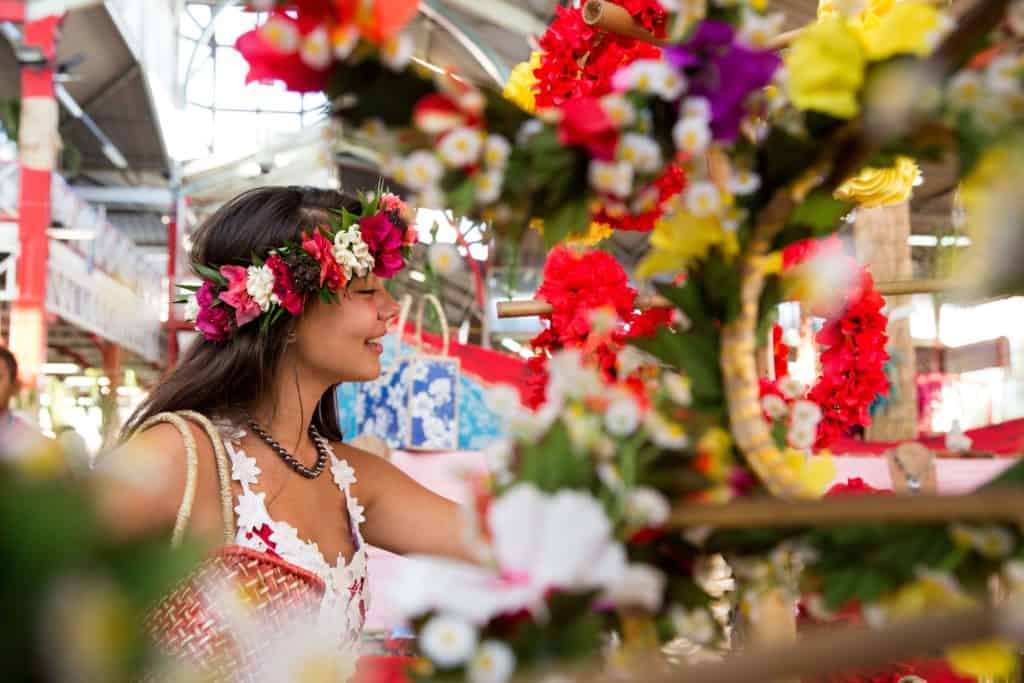
Back in the car, I drive the road that traces the west (or leeward) side of the island. The coastline is magnificent, all palm trees and placid blue water dotted with canoes and sailboats. After a brief stop to snap a photo of the Grotte de Maraa, a deep cavern full of freshwater framed by hanging ferns that was once explored by Jacques Cousteau, I continue to the small town of Papara. Tahiti is sometimes pigeonholed as a transit hub for the other islands, but it’s also a hub for Polynesian culture, and I’ve come here to get an education at the ’Arioi Experience, a center that runs workshops for tourists and local children.
In the vaulted entryway, I’m greeted by a half-dozen women in black dresses. One bangs a rhythm on a drum, another blows a call through a conch shell, another places a lei around my neck. As we walk, one of the women, director of operations Laura Théron, explains the center’s name. “The ’Arioi are a caste from the ancient times,” she says. “They were dancers, they would know the legends, they were very good sailors. And any person from any caste could become an ’Arioi if they were skilled.”
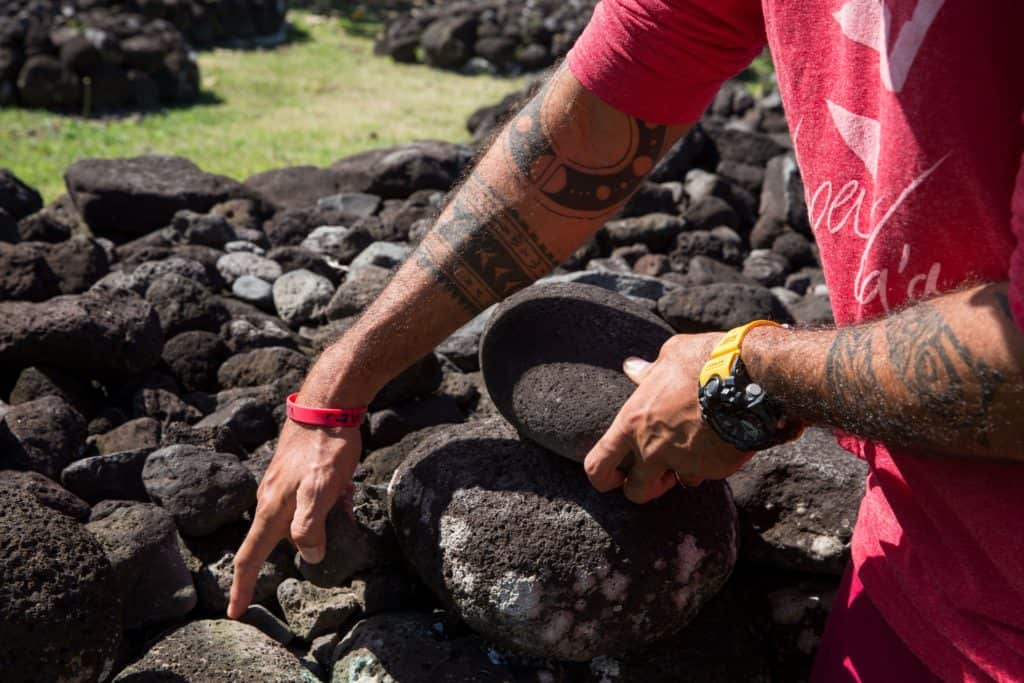
In the center’s performance space, Tekura Amaru, who led the greeting earlier, teaches me how to play a few pehe, or rhythms, on the toere, a three-foot drum made from a hollowed-out log. Ta, ta, tara tata, ta ta tara, tara ta ta. Then, Tara tara ti, ta ta ta. I suck at this, but the young woman who’s performing a Polynesian dance along with the music is able to overcome my rhythmic deficiencies.
My arms are surprisingly sore by the time we’re done. That means I’ve earned lunch, right? We head outside to a sunny garden and sit for a ma’a Tahiti, a classic feast of steamed bananas and taro root grown in the garden here, coconut bread marinated in coconut milk, mango, and a turmeric-laced traditional variant on poisson cru that forgoes the vegetables. Before we dig in, I learn a new word: Manuia! (Cheers!
Just a few minutes north of the center, near the community of Paea, I stop to meet Tahiarii Pariente, a cultural ambassador in a sarong and surf hoodie and a kukui-nut necklace. He’s offered me another history lesson, starting at the Marae Taata. This ancient meeting ground was used for both religious and social gatherings, and was the place where King Pomare declared himself the ruler of Tahiti in 1788. It was partly destroyed, along with many others throughout the islands, after Pomare II converted to Christianity in 1819. “Christianization took away the dancing, the tattoos, the essence of Polynesian lifestyle,” Tahiarii says. “My generation is trying to recreate this lost identity.”
One such effort was the 2011 rebuilding of this marae, now a preserved historical site made up of three basketball court–size spaces enclosed by waist-high walls of tightly packed rocks, each with a raised altar in the middle. “I’m very proud, because I was carrying these stones for three months,” Tahiarii recalls. “It’s the biggest Tetris I ever played.”
As we drive back through Papeete, we chat about the Polynesian cultural renaissance, and how it has become a global phenomenon. “We exported surfing,” Tahiarii says. “It’s a billion-dollar industry today. We have outrigger canoes on the Thames. Every soccer player in the world has Polynesian tattoos. People ask us to bleed them so they can have our mark on them. What kind of reverse colonization is that?” He doesn’t even mention Moana.
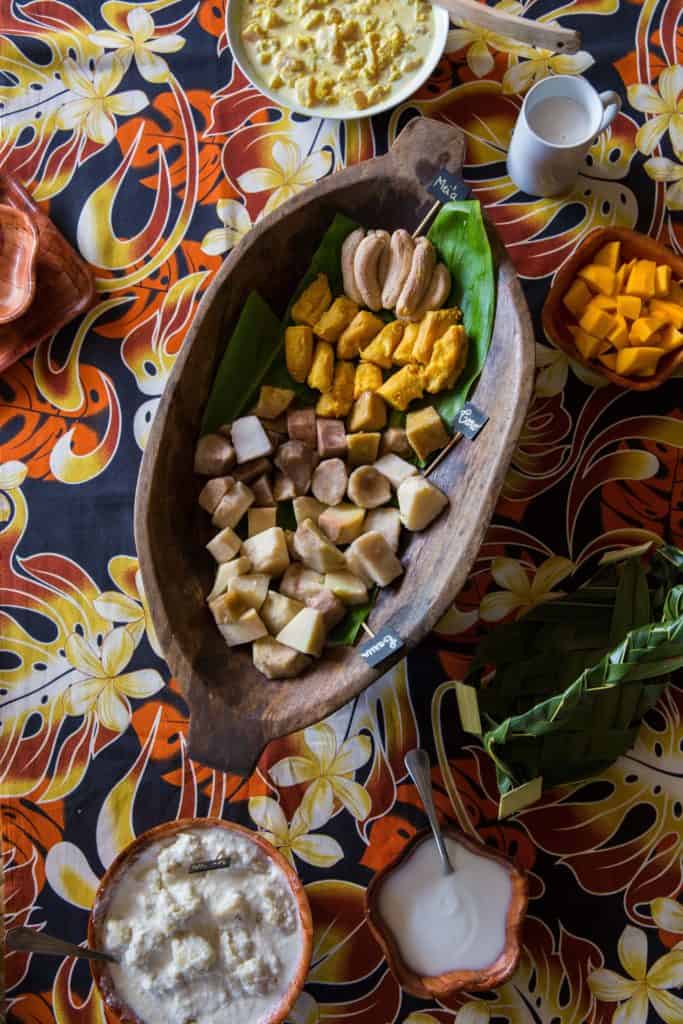
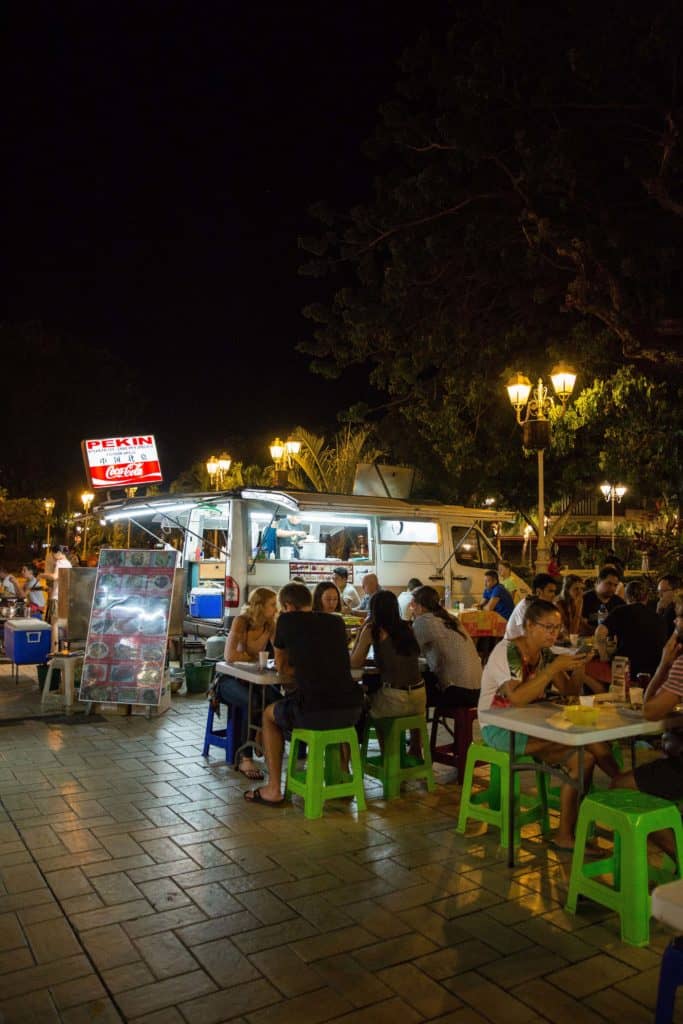
On the other side of town, we stop at Pointe Venus, a peninsula that juts out into Matavai Bay (one of the first sites of contact between Tahitians and European explorers). We walk out onto the black-sand beach to watch canoes racing across the water, and Tahiarii offers to take me out in his own outrigger canoe. (He’s a trained navigator.) I’d love to, but I’m famished, so I partake of a more modern tradition: dining at the roulottes, or food trucks, that park at Place Vaiete, by the Papeete harbor. Tonight, there are about a dozen trucks, serving everything from poisson cru to crepes to pizza to Thai. I opt for the latter, at the appropriately named Tuk Tuk, ordering crunchy spring rolls and a heaping plate of pho lat na rum mit (egg noodles with chicken, beef, and shrimp), which I eat at a plastic table near a trio of musicians playing Tahitian songs on guitar and ukulele.
The only thing more full than my spirit now is my belly, so I’m ready to call it a day. It’s a 15-minute drive over to the InterContinental Tahiti Resort & Spa, where I take a seat on my balcony and sip a Hinano, Tahiti’s favorite beer, while soaking in the moonlight through the palms. Good night, moon.
Day 2
Snorkeling with sharks and sipping pineapple wine in Moorea
I’m back at Place Vaiete for the sunrise, but only briefly. By the time it’s fully light out, I’m on the 30-minute ferry ride to Moorea, a 52-square-mile island with a population of about 16,000. When I debark on the other side, I grab a cab, and about half an hour later I arrive at the InterContinental Moorea Resort & Spa [nb. now closed].
I scarf a quick breakfast—a couple of mini chocolate croissants and some pineapple juice—because I’m due on the dock, where I’m meeting Max and Johanna, my guides with Temoana Tours, who greet me and three other passengers with gardenia leis. As Max steers us through the lagoon, past overwater bungalows and through coral outcroppings, Johanna details the mountains onshore: 3,960-foot Tohivea, which is visible from Papeete; knife-edged Mouaroa, which appears on a French Polynesian coin; Rotui, which separates the island’s two great bays, Opunohu and Cook’s; Mouaputa, which has a peephole carved near the top that’s the subject of a nifty legend in which the demigod Pai pierced the rock wall with a magical spear to stop a heist by the god of thieves, Hiro.
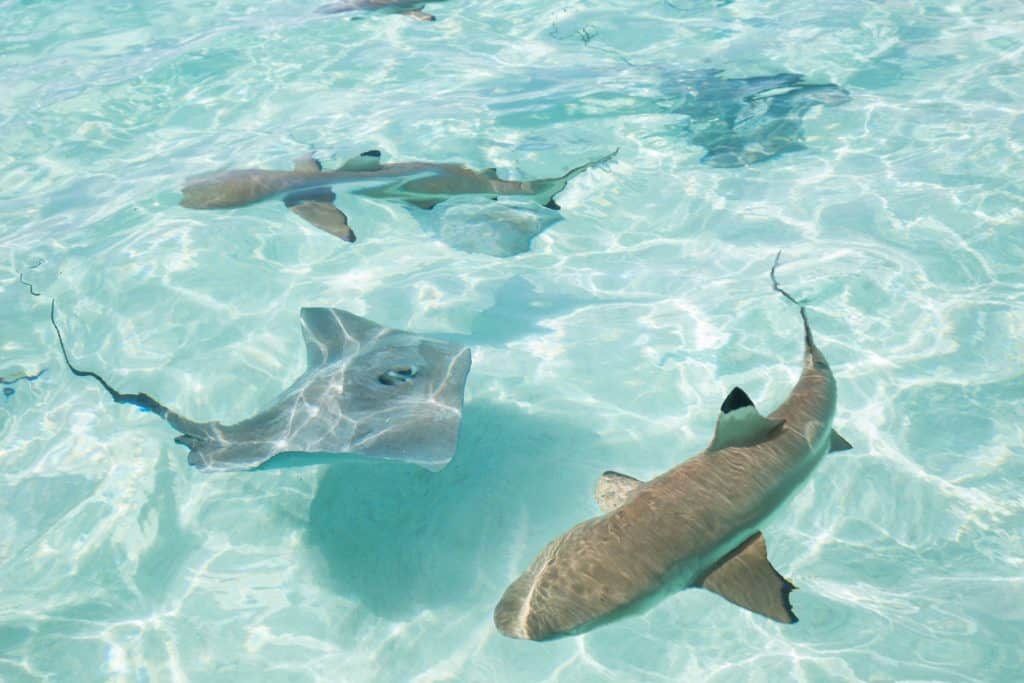
A school of flying fish skitters right in front of us, and a pod of skipper dolphins comes dashing up to the boat, almost close enough to touch. In search of humpback whales, Max steers the boat along a stretch of coastline that appeared in the 1962 Marlon Brando film Mutiny on the Bounty (the actor later built a retreat on Tetiaroa) and past a huge yacht with a helipad. Johanna casually mentions that genetic testing has shown that some Polynesians are descended from the ancient people of Taiwan, and one of my fellow tourists, a young Asian-American woman, practically squeals. “I’m Taiwanese! I listen to the Moana soundtrack nonstop! This explains everything!” She pauses and, after a moment, calmly adds, “I’m having a moment right now.”
Soon, we’re through the reef break and skimming along the ocean. No whales, but a school of flying fish skitters right in front of us, and a pod of skipper dolphins comes dashing up to the boat, a couple of them peeling off to swim alongside for a few moments, almost close enough to touch.
Back inside the reef, we pull up in a patch of lagoon that’s crowded with boats, Jet Skis, and divers. I look down through the turquoise water and see swarms of blacktip sharks and stingrays. Johanna hands me a set of goggles. “The sharks will just swim away if you get close,” she says, “but you can touch the rays. They’re like puppies.” I jump into the bath-warm water, coming nearly within arm’s length of the quicksilver sharks, even closer to the magical rays flapping their aquatic wings. I’m hesitant to reach out my hand until Max, right behind me, gently swings a big, docile ray around so I can carefully brush the skin with my fingertips. It’s astonishingly soft, like velvet.
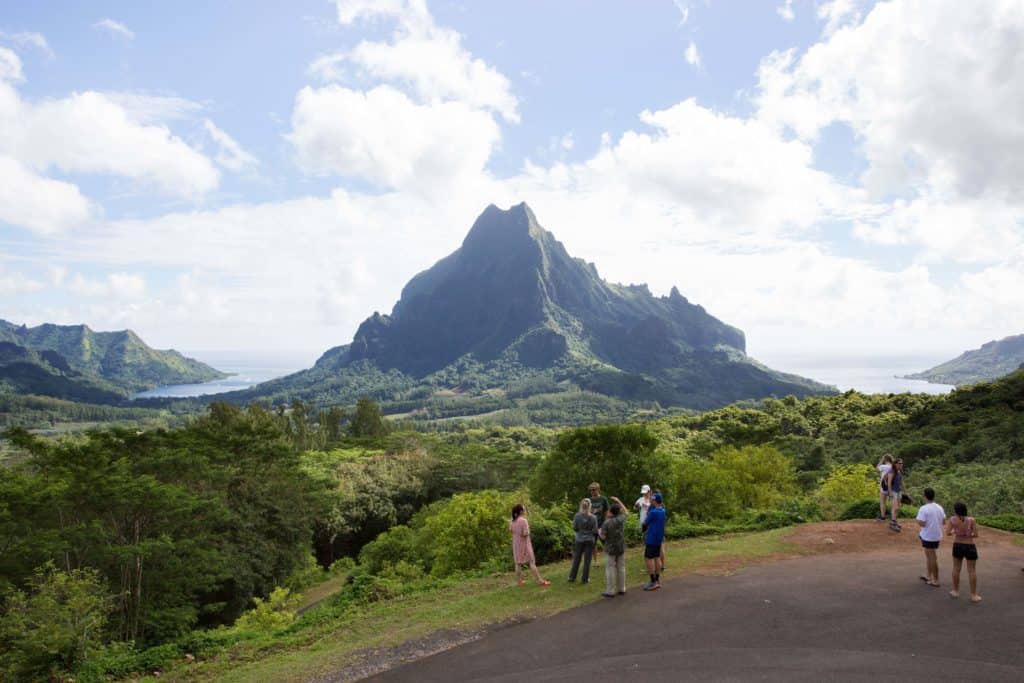
Back on the boat, we zip over to a motu (a small reef islet), where Johanna’s husband, a burly Tahitian named Teva, is grilling lobsters and tuna steaks over a fire. We sit at a plastic table planted in the lagoon, our feet dangling in the water as we gobble up all the grilled fare, along with a pile of rice, a side of poisson cru, and a bottle of rosé.
I’m so exhausted and stupefied by the awesomeness of the morning that I can barely put the words together to thank Max and Johanna when they drop me back at the InterContinental. But I’m curious how the island looks from up on those mountains, so I hire a taxi to take me to Belvédêre Lookout.
As we circumnavigate Opunohu on the rim road, we see a helicopter landing on the yacht from earlier. “That’s Tom Cruise’s yacht,” says my driver, a perpetually bemused Polynesian named, coincidentally, Tom. I refuse to fact-check him on this.
Just past the bay, we take a right through flat farmland, past cows and horses and pineapple fields. (Fun fact: the Tahitian word for pineapple is painapo; Captain James Cook brought the fruit here from Brazil.) Then we begin to climb, mountains all around us, past bamboo groves, the road growing steeper, winding tighter, until we reach the lookout. There are about a million other tourists up here, all taking in the view of the bays and Mount Rotui. Next to me, a photographer climbs onto her friend’s shoulders to get a better angle. I half expect a dragon or a pterodactyl or some Polynesian god to come soaring into her shot.
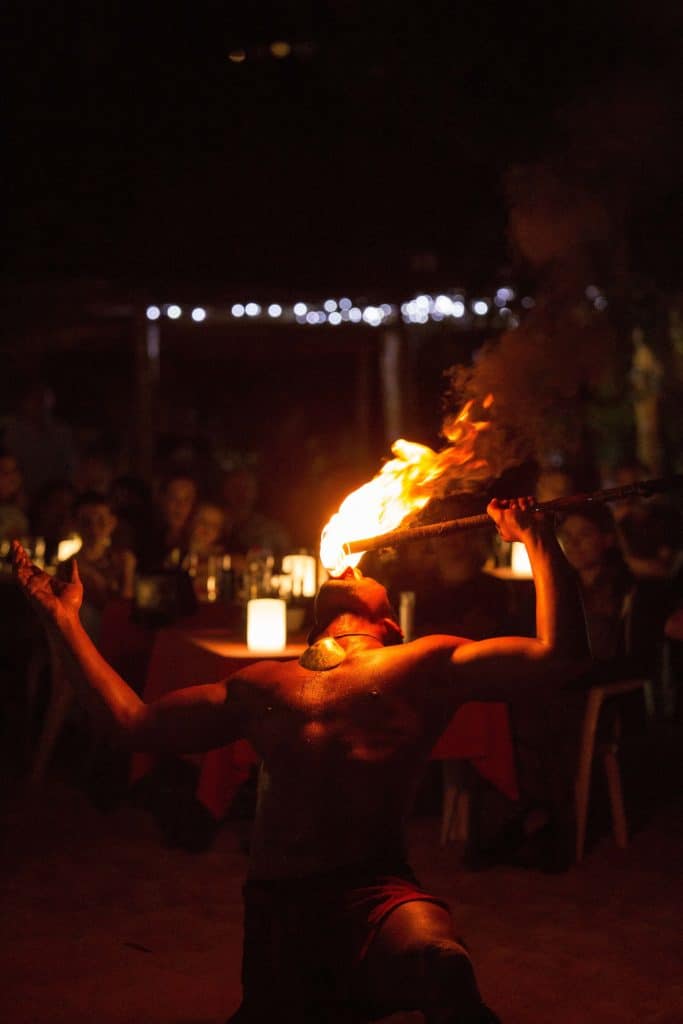
Tom returns me to the InterContinental, where I crack a Hinano and lounge on the deck of my overwater bungalow. Suddenly, a spotted eagle ray, glowing beautiful and alien, glides through the water right below me. I jump in to get a closer look, but in just a few seconds the creature is gone.
After a shower and a change of clothes, I lazily catch a shuttle across the road to Holy Steak House. Sitting next to the wine cabinet, I spot a bottle of Manutea Brut D’Ananas. Pineapple sparkling wine? Yes, please! I polish off a couple of glasses—god, it’s sweet—along with a perfect medium-rare New Zealand sirloin fillet and a grilled lobster.
I feel as if I don’t even have the juice left to make it to my bed, but as I cross the resort, I’m drawn by a hint of music on the breeze. Past the pool, I find a dozen grass-skirted dancers, some twirling torches, on a white-sand beach in front of a Polynesian band. I know what you’re thinking: Fire dancers? What a cliché! And you’re not wrong. But the hypnotic effect of the spinning flame (and the revolutions of those hips) leads me to the conclusion that paradise being cliché doesn’t make it any less paradisiacal.
Day 3
Taking in the beauty of Bora Bora from the sky and the sea
I’m up early one more time, to catch the first flight out of Moorea’s tiny airport. The plane is in the air for just 50 minutes, passing over several islands (Raiatea, Tahaa) that are so stunning I can’t believe we’re not landing on them. Those aren’t Bora Bora?
But then I see our destination. This island has captured the imaginations of travelers perhaps more than any other in the Pacific. To even call it an island isn’t quite right. There’s a central landmass, and on it the undulant peak of Mount Otemanu, which soars spectacularly to 2,385 feet, but this has become the planet’s premier honeymoon destination for its motus (and the overwater bungalows they house), which circle the main island, and for the lagoon water, which switches from brilliant turquoise to indigo and back again, depending on the depth and the presence of coral, shades swirling around each other as if mixed on some crazed artist’s palette. If only Gauguin could have seen it from these heights.
Bora Bora’s airport is on one of those motus, but while the other passengers from my flight head down to the boat dock to be ferried to their hotels, I’m intent on ascending once more. I meet Tahiti Air Charter captain Stéphane Rozain in the airport lobby, and he leads me and a few other tourists back out onto the runway, to his eight-seat Cessna 208 seaplane. Soon we’re doing laps above the motus, before zipping out to nearby Tupai, known as the “heart-shaped island” because it appears as if some love-smitten goddess absentmindedly sketched a curlicue heart of white sand and palm trees around a shimmering teal lagoon. It seems impossible that French Polynesia keeps topping itself, but Tupai is the most jaw-dropping thing I’ve seen yet.
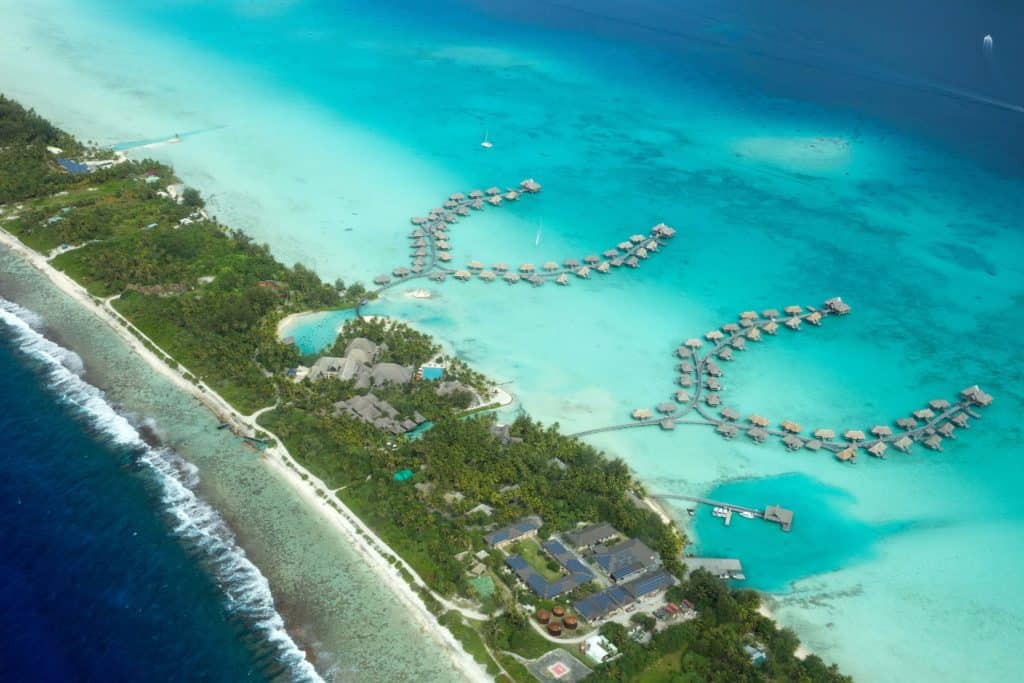
The flight is over in just half an hour, and while I’m momentarily aggrieved at having to set my feet on the ground, in just a few minutes I’m on a boat motoring across the lagoon to the Four Seasons Resort. I’ve decided to treat myself, first to eggs Benedict and mango juice at the hotel’s open-air breakfast restaurant, then to a massage.
You expect a certain level of opulence in Bora Bora, at the Four Seasons, but even so, my treatment room at the spa is extravagant. It’s in a private overwater building, and as I lie down I find myself looking through a window in the floor at tropical fish cruising through the coral in the lagoon below. The aquarium ceases to exist—along with everything else in the world—the moment the masseuse digs into the knots in my back.
Unkinked, I stop in my bungalow to change clothes (and maybe, just maybe, jump in the lagoon). Then I hop a water taxi over to the main island for lunch at Restaurant St. James. The menu offers locally tinged French fare, and I order the Polynesian Fusion appetizer, which features four preparations of ahi tuna (including, yes, poisson cru), and a rich and creamy mushroom risotto. As my waitress drops off the check, she points out a sea turtle floating in the water, no more than 15 yards from us.
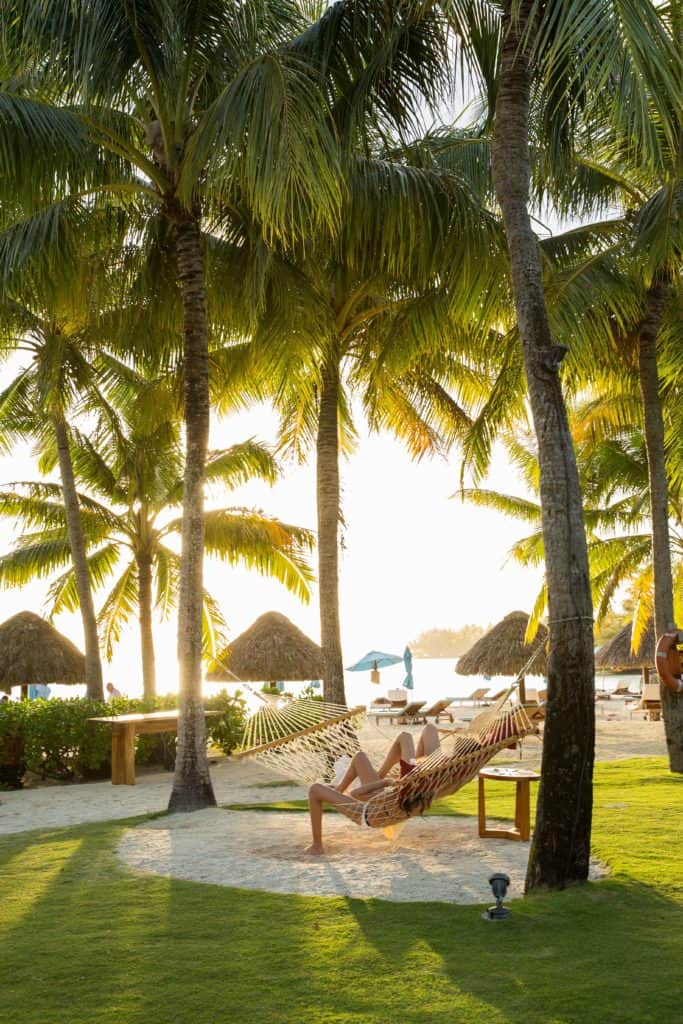
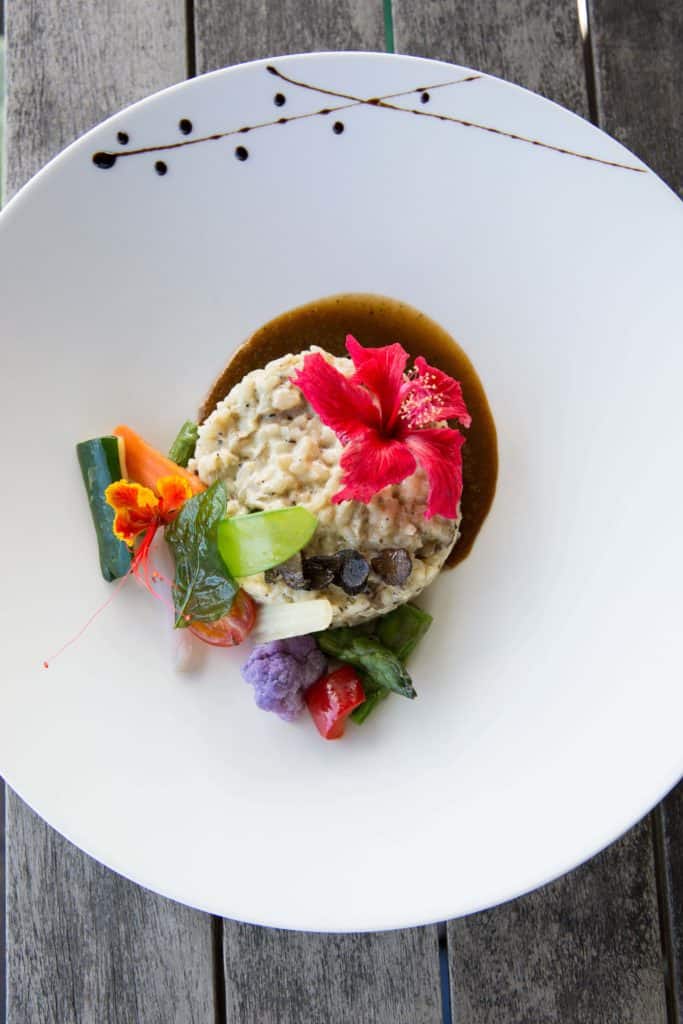
I walk off lunch with a short stroll to the center of Vaitape, the biggest town (population 4,927) on the island, stopping to buy some black pearls—French Polynesia’s signature jewel and largest export—from a roadside vendor. At the dock, I join a crew of scuba novices for an introductory lesson with TOPdive. I’ve never done a scuba dive before and am mildly terrified, and the guides definitely pick up on this. After fitting us with (extremely tight) wetsuits and giving an explanation of the basic gear and techniques, one of the instructors, a Belgian named Nicolas, turns to a newbie and tells her: “OK, we throw you in for two minutes to check for tiger sharks, and then the rest of us will follow.”
In the water, it takes me a few minutes to get used to the breathing—exhale when you want to sink, inhale when you want to rise—but once I do, I find myself utterly enchanted. Bright fish dart among the coral, some swimming straight at me, only to veer off just before I can touch them. I skirt a tremendous rock wall, then dive to the bottom to touch the sand and shells on the floor. I’m only 15 or 20 feet below the surface, and yet I’m in a completely different universe.
When I surface at the stern of the boat, Nicolas reaches down and pulls me onboard. I tell him I can see how people get addicted to this. “Yeah,” he replies. “I went to the hospital and tried to get a cure, but they had nothing for me.”
Another first-timer climbs onto the boat behind me and screams, “I’m a merman!” I’m only 15 or 20 feet below the surface, and yet I’m in a completely different universe.
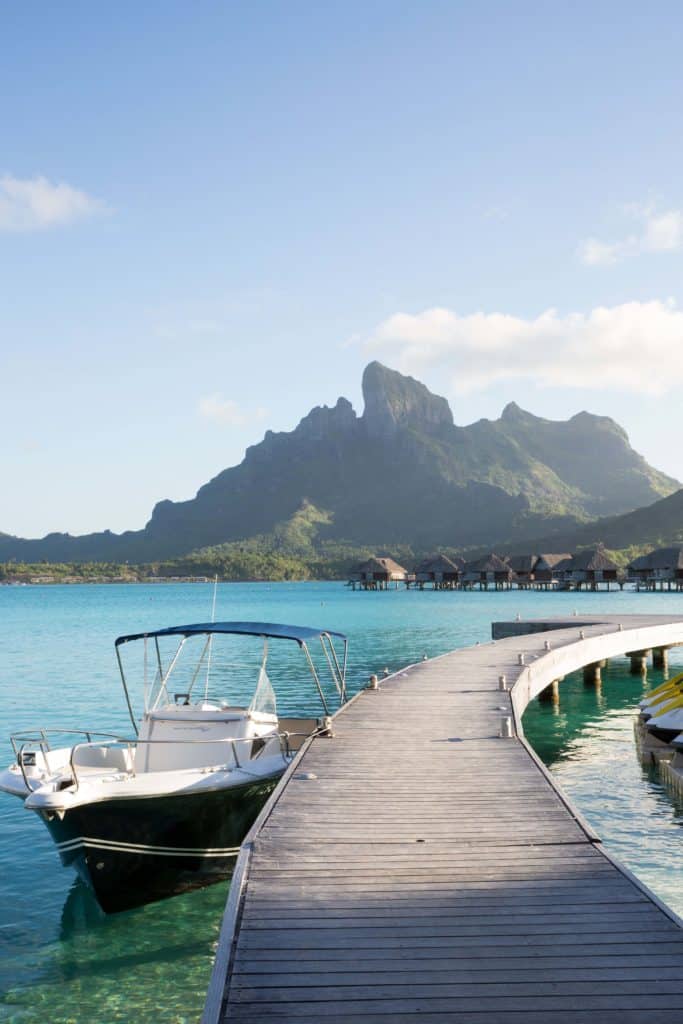
As amazing as I find the underwater world, I’m not quite ready to trade my feet for fins. So the TOPdive guys drop me off at the Conrad Bora Bora Nui, a resort that climbs from a white-sand beach to the top of a hill on the leeward edge of an otherwise uninhabited motu. I hustle up to the top, where I have a glass of Champagne while I watch the setting sun turn the edge of the earth orange. Once the sun is down, I head back down to the resort’s flagship restaurant, Iriatai. A light breeze blows across the now black lagoon and through the palms and lightly brushes my face as I enjoy an egg parfait with asparagus foam and Parmesan, and an incredible confit of mahi mahi in lemongrass-coconut sauce. I also knock back a Laga Choco Ananas cocktail, made with chocolate-infused Lagavulin Scotch, pineapple, chocolate bitters, and brown sugar.
Waiting for my water taxi on the hotel dock, I scan the skies. The moonlight glints off the lagoon, and the stars seem to burst from the heavens. After a minute, I find the constellation I’m looking for. As I start singing to myself, “When you see the Southern Cross for the first time, you understand now why you came this way,” I hear the hum and swish of an approaching boat. But I’m not going anywhere. Not yet.
Next Up: Three Perfect Days: Montana
